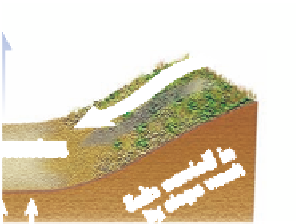Geoscience Reference
In-Depth Information
the Earth's surface is covered with water, mostly contained in
oceans. Of the remaining 29% of the Earth's surface, significant
parts of the land area are simply unsuitable for large-scale agri-
culture on a sustainable basis. Such places include the world's
arctic and subarctic climate zones, the major desert regions, and
large parts of the tropical rainforests. In fact, only 22% of the
Earth's land area is potentially productive for agriculture. Of
these areas, only a few such as the American Midwest, south-
eastern Asia, parts of South America, and eastern Europe are
ideal for intensive agriculture because they have fertile soils
and abundant precipitation.
With the increasing demand for food, more and more agri-
culture is being practiced in marginal lands where the potential
for major environmental degradation is high. In Chapter 18,
two such examples of human impact were the overplowing of
soils that created the American Dust Bowl of the 1930s and
changing land-use policies that led to massive desertification in
the Sahel region of Africa. This second case study focuses on
another environmental impact of expanding agriculture in arid
and semi-arid regions. This impact is
soil salinization
, which
is the accumulation of soluble salts such as sulfates of calci-
um and potassium in soil. Salt buildup in soils is toxic to most
plants because salts decrease the osmotic potential of the soil,
that is, the ability of soil water to enter permeable plant roots.
As soils become increasingly salty, they have greater concentra-
tions of solute than the plant roots do, so plants cannot absorb
water from the soil.
Salinization of soils can occur under natural conditions
and is most commonly associated with topographic depres-
sions (Figure 20.11). In these microenvironments dissolved
salts are washed by overland low into the low area, or alter-
natively, the base of the depression lies just above the water
table. The source of these salts can either be the weathering of
minerals on the slopes above the depression, ions precipitated
in the rainwater, or solutes leached from saline rocks such as
gypsum. If the salts are washed into the depression from the
nearby slopes, they will recrystallize at the surface when the
water evaporates. If the water table is shallow, salts can be
brought up from deeper horizons by the process of capillary
action (or “wicking”) described in Chapter 15. When excess
salts accumulate, soil structure breaks down because clays no
longer bind together. Recall from Chapter 11 that soils with
a moderate amount of clay typically have good structure,
which allows water to flow through the soil rapidly. When this
binding ceases, the clay particles act individually to plug soil
pores. As a result, the soil becomes increasingly impermeable
to water.
Soil salinization can also occur when agricultural prac-
tices change the hydrological and chemical aspects of soils.
This change can happen in two ways. One way is related to
Water evaporates
S
S
S
S
S
S
S
S
S
S
S
S
S
S
a
t
t
t
t
Salts accumulate
t
s
s
s
s
s
s
s
s
a
a
a
a
a
a
a
a
a
a
a
a
a
a
a
a
a
c
c
c
c
u
m
m
m
m
m
m
m
m
m
m
m
m
m
m
m
u
S
t
s
a
c
S
S
S
m
Capillary rise
(wicking)
(a)
(b)
Figure 20.11 Natural salinization of soils.
(a) Salt crusts natu-
rally form in topographic depressions within arid regions because
slopewash evaporates and leaves a salt crust behind. (b) Salt
crust at Bad Water in Death Valley, California. This playa con-
tained water during the Wisconsin ice age that evaporated dur-
ing the Holocene, leaving mineral salts behind. Today, occasional
rains promote runoff into the playa. Some salts dissolve and then
recrystallize when the water evaporates. The hexagonal pattern
results from repeated freeze/thaw and evaporation cycles that
push the crust into these forms.
rising water tables associated with the clearing of native veg-
etation (Figure 20.12). In arid and semi-arid areas where natu-
ral vegetation occurs, rainwater typically leaches salt from the
permeable soil deep into the ground and into the groundwater.
Even though the salinity of the groundwater is high in these
circumstances, native plants do fine as long as the water table
is about 4 m (13 ft) below the surface. In places where the
water table is shallower, some native plants such as salt grass
can cope with higher levels of groundwater salinity. When na-
tive vegetation is cleared in these areas, the water table typi-
cally rises because less precipitation is intercepted by plants
and less evapotranspiration occurs. If the water table rises to
within about 2 m (~6.5 ft) of the ground, saline water can
begin to seep into topographic depressions and salt crusts can
form through evaporation. In addition, saline water can begin
to rise to the surface by capillary action. In this way, soils
become laden with salts.
Soil salinization
The process in which soils become en-
riched in soluble salts such as sulfates from calcium and
potassium.














































































